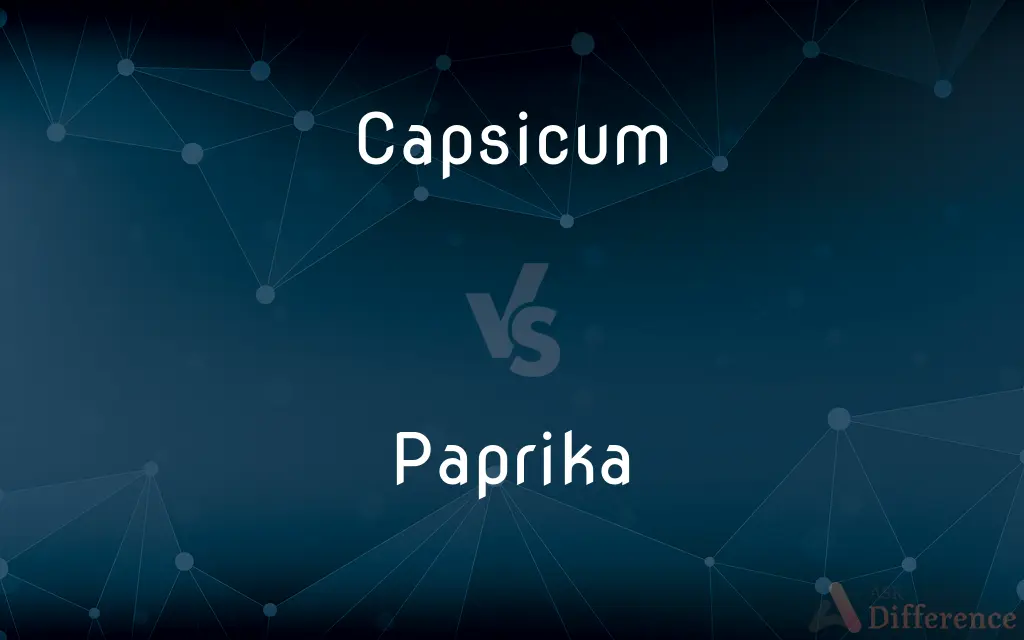Capsicum vs. Paprika — What's the Difference?
By Urooj Arif & Fiza Rafique — Updated on March 25, 2024
Capsicum refers to a wide variety of pepper plants, while paprika is a spice made from dried and ground Capsicum peppers.

Difference Between Capsicum and Paprika
Table of Contents
ADVERTISEMENT
Key Differences
Capsicum is the genus of flowering plants that includes bell peppers, jalapeños, and other varieties of peppers, known for their distinctive flavors and heat levels. On the other hand, paprika is a specific spice created by grinding dried Capsicum peppers, often with a mild flavor profile but also available in hotter varieties.
While all paprika is made from Capsicum, not all Capsicum peppers are used to make paprika. Paprika typically comes from certain varieties of peppers that are specifically cultivated for their color, sweetness, or mild heat. Capsicum peppers vary widely in size, color, and heat intensity, ranging from sweet bell peppers to extremely hot habaneros.
In terms of culinary uses, Capsicum peppers can be consumed fresh, cooked, or preserved and are used worldwide in a multitude of dishes for flavor, spice, and color. Paprika, however, is used primarily as a seasoning or garnish, adding color and flavor to dishes like goulash, soups, and stews.
Capsicum peppers are rich in vitamins and antioxidants, contributing to various health benefits, such as improved immunity and reduced inflammation. While paprika retains some of these benefits, its nutritional value depends on the type of Capsicum pepper used and the concentration of the spice.
The cultivation of Capsicum involves growing the plants from seeds in warm climates, often requiring specific conditions for optimal growth. Paprika production, conversely, involves the additional steps of drying and grinding the peppers, with some regions, like Hungary and Spain, known for their distinctive paprika varieties.
ADVERTISEMENT
Comparison Chart
Definition
Genus of flowering plants including various peppers.
Spice made from dried and ground Capsicum peppers.
Varieties
Includes bell peppers, jalapeños, habaneros, etc.
Ranges from sweet to hot, depending on the pepper used.
Culinary Uses
Fresh, cooked, or preserved in diverse dishes.
Seasoning or garnish, adds color and flavor to dishes.
Nutritional Value
High in vitamins A and C, antioxidants.
Depends on pepper used; generally retains vitamins.
Production
Grown from seeds in warm climates.
Made by drying and grinding specific varieties of peppers.
Compare with Definitions
Capsicum
Consumed fresh, cooked, or preserved, offering a range of flavors and heat.
Capsicum peppers are essential ingredients in salsas and spicy dishes.
Paprika
The production involves drying and grinding peppers, with regional varieties.
Spanish and Hungarian paprikas differ in flavor and heat intensity.
Capsicum
Rich in vitamins A and C, contributing to health benefits like improved immunity.
Including Capsicum peppers in the diet can help boost vitamin intake.
Paprika
A spice made by grinding dried Capsicum peppers, known for its vibrant color.
Paprika adds a beautiful red hue and subtle flavor to creamy sauces.
Capsicum
A genus of flowering plants that includes a wide variety of peppers.
Capsicum annuum includes bell peppers and jalapeños, popular in many cuisines.
Paprika
Originates from specific Capsicum varieties, often with a mild flavor.
Sweet paprika is made from bell peppers, providing color without heat.
Capsicum
Offers a variety of heat levels, from sweet bell peppers to hot habaneros.
The heat level of Capsicum peppers is measured on the Scoville scale.
Paprika
Used primarily as a seasoning in dishes like goulash and soups.
Paprika is a key ingredient in Hungarian cuisine, especially in goulash.
Capsicum
Cultivated worldwide, requiring warm climates for optimal growth.
Capsicum is grown extensively in India, China, and Mexico, among other countries.
Paprika
Retains some nutritional value of Capsicum, including vitamins and antioxidants.
Paprika can contribute to dietary intake of antioxidants, though in smaller amounts than fresh peppers.
Capsicum
Capsicum () is a genus of flowering plants in the nightshade family Solanaceae, native to the Americas, cultivated worldwide for their chili pepper or bell pepper fruit.
Paprika
Paprika (American English more commonly (listen), British English more commonly (listen)) is a spice made from dried and ground red peppers. It is traditionally made from Capsicum annuum varietals in the Longum group, which also includes chili peppers, but the peppers used for paprika tend to be milder and have thinner flesh.
Capsicum
Any of various tropical American pepper plants of the genus Capsicum, especially any of the numerous cultivated forms of the species C. annuum and C. frutescens.
Paprika
A powdered spice with a deep orange-red colour and a mildly pungent flavour, made from the dried and ground fruits of certain varieties of pepper.
Capsicum
The fruit of any of these plants, especially the dried pungent types used as a condiment and in medicine.
Paprika
A powdered seasoning made from sweet red peppers, ranging in flavor from mild to hot.
Capsicum
Any of several tropical American plants, of the genus Capsicum, principally the species Capsicum annuum and Capsicum frutescens, that are cultivated as edible peppers.
Paprika
A dark to deep or vivid reddish orange.
Capsicum
The spicy fruit of the above plants, the bell pepper.
Paprika
(uncountable) Powdered spice made from dried and ground fruits of sweet pepper (bell pepper) or chili pepper (cultivars of Capsicum annuum), or mixtures of these (used especially in Hungarian cooking).
Capsicum
A genus of plants of many species, producing capsules or dry berries of various forms, which have an exceedingly pungent, biting taste, and when ground form the red or Cayenne pepper of commerce.
Paprika
(countable) A variety of the spice.
Capsicum
Any plant of the genus Capsicum (of the Solanaceae family, which are unrelated to Piper), and its fruit; red pepper; chili pepper; as, the bell pepper and the jalapeno pepper (both Capsicum annuum) and the habanero pepper (Capsicum chinense); .
Paprika
A dried but not yet ground fruit of sweet pepper (bell pepper) or chili pepper sold for use as a spice.
Capsicum
Any of various tropical plants of the genus Capsicum bearing peppers
Paprika
A bright reddish orange colour resembling that of the ground spice.
Paprika
Of a bright reddish orange colour, like that of the dried paprika.
Paprika
The dried ripened fruit of Capsicum annuum or various other species of pepper; also, the mildly pungent condiment prepared from it.
Paprika
Plant bearing large mild thick-walled usually bell-shaped fruits; the principal salad peppers
Paprika
A mild powdered seasoning made from dried pimientos
Common Curiosities
What defines paprika?
Paprika is a spice made from dried and ground Capsicum peppers, known for its color and flavor.
How are Capsicum peppers used in cooking?
They can be eaten fresh, cooked, or preserved, used to add flavor, heat, and color to dishes.
Can all Capsicum peppers be used to make paprika?
While technically possible, paprika is usually made from specific types of Capsicum peppers chosen for their color and mild flavor.
How does the flavor of paprika vary?
The flavor can vary from mild and sweet to pungent and hot, depending on the Capsicum variety and processing method.
How is Capsicum cultivated?
Capsicum is grown from seeds in warm climates and requires specific conditions for optimal growth.
What is Capsicum?
Capsicum is a genus of flowering plants that includes a variety of peppers, ranging from sweet to hot.
What is the primary use of paprika in cooking?
It is used mainly as a seasoning or garnish to add color and flavor to dishes.
Can paprika be made from hot peppers?
Yes, there are hot varieties of paprika made from spicier Capsicum peppers.
What makes Hungarian paprika different from Spanish paprika?
Hungarian and Spanish paprikas differ in flavor, color, and heat due to variations in the Capsicum peppers used and the processing methods.
Does paprika retain the health benefits of Capsicum peppers?
Yes, to some extent, depending on the type of pepper used and the concentration of the spice.
What process is involved in making paprika?
Paprika production involves drying and grinding Capsicum peppers, with variations in process depending on the region.
What are the health benefits of Capsicum?
Capsicum peppers are high in vitamins A and C and antioxidants, which can improve immunity and reduce inflammation.
What is the significance of the Scoville scale?
The Scoville scale measures the heat level of Capsicum peppers, indicating their spiciness.
Are there different types of paprika?
Yes, paprika can range from sweet to hot, influenced by the variety of Capsicum pepper used.
Is paprika used in cuisines outside of Hungary and Spain?
Yes, paprika is used in a variety of cuisines around the world, adding color and flavor to numerous dishes.
Share Your Discovery

Previous Comparison
Bonnet vs. Hood
Next Comparison
Village vs. CountrysideAuthor Spotlight
Written by
Urooj ArifUrooj is a skilled content writer at Ask Difference, known for her exceptional ability to simplify complex topics into engaging and informative content. With a passion for research and a flair for clear, concise writing, she consistently delivers articles that resonate with our diverse audience.
Co-written by
Fiza RafiqueFiza Rafique is a skilled content writer at AskDifference.com, where she meticulously refines and enhances written pieces. Drawing from her vast editorial expertise, Fiza ensures clarity, accuracy, and precision in every article. Passionate about language, she continually seeks to elevate the quality of content for readers worldwide.
















































